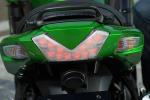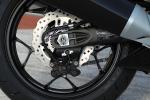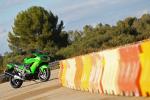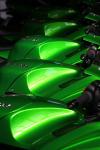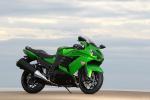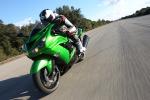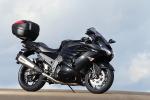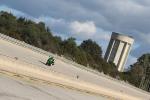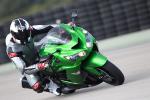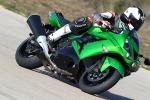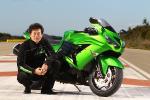Kawasaki ZZR1400 ZX-14 review
By Kevin Ash - 16/12/2012
The claims are unequivocal: more power and harder acceleration than any other production bike, and the press launch venue was Europe‘s fastest vehicle proving ground. Has Kawasaki forgotten the ZZR1400 is a road bike?
It seems not. Leader of the project to upgrade and modernise Kawasaki‘s flagship super tourer (ZX-14 in many markets, ZZR1400 in Europe), Takeru Oshima, expressed some concern at the nature of our first ride of his new baby, which took place entirely within the Nardo proving ground in the heel of Italy. This included the breathtaking 7.8 mile (12.5km) circumference ring with its four banked lanes designed for sustained high speeds even higher than the ZZR1400‘s claimed 186mpgh (300kph) maximum.

There was also a stretch of wide, level and dead straight track for acceleration tests, where terminal speeds were closing in on 160mph (260kph), and what was labelled a handling course, which anywhere else would be called a race track.
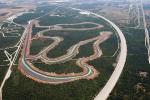
Oshima was worried the bike's more relevant strengths might not come to the fore, but I did my best. I cruised around the track pretending I was overtaking cars, sitting upright as well as hanging off the side of this big and imposing motorcycle, I looked in the mirrors, picked my nose, honked the horn at the photographers, checked for turbulence off the screen and explored the lower reaches of the rev range. But sadly, I never got to ride this road bike on the road, for real.

The ZZR1400 is of course phenomenally, gigglingly fast, and so it should be with the major technical makeover carried out by Oshima. The engine has been taken out from 1352cc to 1441cc through a 4mm increase in stroke to 65mm. The bore remains the same at 84mm. This has led to an increase mostly in the mid-range and high rev horsepower, helped by a small reduction in the final drive ratio - the rear sprocket is up one tooth to 42. The company claims 197bhp (200PS, 147.2kW), boosted to 207bhp (210PS, 154.6kW) by the Ram Air induction, although there‘s some caginess about this, with some Kawasaki staff quietly suggesting the figures might prove to be even higher when magazines start to strap ZZR1400s to dynos.
This is achieved by using revised combustion chamber shapes with a higher, 12.3:1 compression ratio and new intake and exhaust port shapes. These are hand finished, and the exhaust pots have a larger diameter to expediate gas flow from the engine. The exhaust headers are fatter for the same reason. The valve sizes are the same but the cam profiles feaure increased lift. Internal pumping losses are reduced through increasing the size of bypass holes between the cylinders, and this is claimed to be a major factor in the 2012 ZZR1400's power increase.
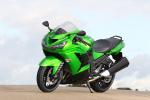
Other changes are designed to maintain or improve durability, such as bigger small end bearings, a stronger crank and so on. But there‘s also a useful improvement in fuel consumption, made by automating the ‘Economy‘ switch found on the 1400GTR. This advances the ignition timing significantly when engine loads are light (most of the time with a motor this powerful), and with other changes to the engine management has made the ZZR1400 up to 20 per cent more fuel efficient, although most of the time an owner would expect to see an 8 per cent advantage over the outgoing model.
The additional power means additional heat to lose, so the radiator is fitted with a second fan while the bodywork has more pronounced fins in the flanks of the fairing to improve heat dissipation while keeping it away from the rider and passenger - Kawasaki says the amount reaching them is significantly reduced.

The ZZR1400's chassis is based on the old monocoque design and looks little different, but has increased rigidity in the headstock and swingarm areas, while the swingarm itself is 10mm longer and more rigid. Stiffer springs are used in the suspension with revised damping to provide a sportier ride and sharper handling, aided by the fitment of lighter wheels - 0.8lb (360g) at the front and 2.27lb (1030g) at the rear. These wear versions of Bridgestone‘s new S20 Battlax rubber designed for heavyweight machines. The ABS system has been improved, particularly when braking on bumpy surfaces.
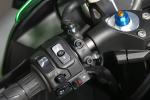
The electronics keep pace with the latest from the European manufacturers, including Kawasaki‘s outstanding KTRC 3-mode predictive traction control system. Modes 1 and 2 are track-style options designed to maximise acceleration, as on the ZX-10R Ninja, while 3 is a safety mode for riding in poor conditions. They can be switched off altogether if required. The system also differentiates between torque-induced wheelies, which it allows, and more dangerous sudden ones, where it intervenes. In mode 3 all wheelies are prevented.

There are two engine power modes, with Low Power reducing output from the midrange onwards by up to 25 per cent, and more usefully softening the throttle response across the range.
The styling meanwhile is recognisably ZZR1400 but most noticeably with a more aggressive mien about the quad headlight visage. As mentioned, the side fins are more pronounced, and additionally the seat is new along with the tail section, although the same rear lights are used. The exhaust silencers are larger and a new shape.

The instruments now include ambient air temperature and, according to Kawasaki, a more accurate fuel gauge and range-to-empty reading. Everything is controlled via a switch on the left handlebar. The overall finish is very clean, with a lot of attention paid to keeping fasteners and brackets out of sight, while a pair of luggage hooks folds out neatly and with a satisfying click from beneath the seat.
Not that we were carrying any luggage at Nardo. The high speed runs certainly proved the ZZR1400's phenomenal performance though. You know you‘ve been riding fast when you slow down again and feel like you could get off, then spot the speedo still reading 160kph (100mph). Following Kawasaki‘s lead rider around, I first took the bike up to 200kph (125mph) for a few kilometres and found this straightforward to cruise at. You can sit normally rather than having to duck down, although if you do there‘s a patch of turbulence affecting your helmet half way between prone and sitting normally. Otherwise, in the real world the aerodynamics work very well, being both quiet and smooth.

Now drop a couple of gears and pin the throttle for maximum thrust, which pushes you back in the seat hard even from this speed. The speedo winds round past the final 280kph figure to roughly where 300kph (185mph) would be at an almost constant rate, underlining that without electronic intervention, the bike would keep on going faster than this. But as you reach this point there‘s a stuttery response, smoother than a rev limiter but still very noticeable, as if the bike‘s fighting a blustery headwind. It‘s not, it‘s the limiter saying this is enough.
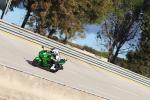
The feel of the ZZR1400 at this speed is stable, as you‘d rather hope, although there‘s a certain vagueness that‘s a little disconcerting until you get used to it. But it‘s not just a high speed trait, in fact at normal road speeds, as on the handling circuit, the feel of the steering in a straight line is somewhat anaesthetic. It‘s not the slightest bit unstable but you don‘t feel completely connected to the front wheel, until you peel it into a turn. Then the suspension and tyres load up and the big bike turns with surprising agility and tactility. It might not be a track bike but you can take it around one anyway, and with all that power on tap and the brilliantly capable KTRC to control the release of thrust, you‘re going to be very hard to beat.
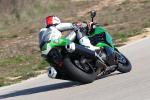
In KTRC mode 1 the bike squirms and scrabbles for grip when you wind open the throttle to drive out of a corner, yet once you‘re used to this it feels - and is - perfectly safe, while the bike fires itself onto the straight with staggering thrust. Mode 2 is the one to try first if you‘re not familiar with these systems, and even that will have most riders powering from lean to upright faster than they‘ve ever done before.
The ZZR1400's brakes are equally competent, but inevitably there‘s a squashy feel that imparts little useful information. The ABS cuts in smoothly and doesn‘t interfere to early, even on the circuit, although there was no opportunity to check its ability on bumpy surfaces. High performance riding is about relying on the electronics as much as tactility so there‘s less riding satisfaction to be had than on a pure sports bike, but the sheer ferocious speed of the bike, and crucially how easy it is to access that speed, is a huge pleasure in its own right.
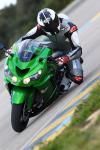
Launching the bike off the line is much the same story. It‘s fastest either in KTRC mode 1 or with this switched off altogether, although the lack of wheelie control when you do affects confidence at first, as you‘re unleashing an awful lot of power when you let go the light clutch (now a slipper design for 2012). This has a slightly vague bite point, but that aside the ZZR1400 is remarkably easy to fire at the horizon. You won‘t find much else on the roads - or even at vehicle proving grounds - going past you either.
What was noticeable on my road simulations was that the old ZZR1400‘s lack of low rev torque has been addressed, but not by enough. I‘ll qualify this by saying it will need confirming in a future real world road test, but it felt on the launch that acceleration below 4,000rpm in the higher gears was adequate rather than hard. Crack open the throttle on a Multistrada at this level and bike launches forward, where the ZZR1400 is more mushy and soft. I suspect you‘ll still need to drop a gear or two to overtake cars, especially two up and loaded for touring, which is disappointing.
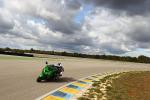
It means that for much of the time on the road, this astoundingly fast bike won‘t always feel especially quick. Maybe that‘s a good thing as it‘s all relative, the slow bits of this bike are still fiendishly fast compared with most other traffic. But to sample full strength ZZR1400 you‘ll still need to play with the gearchange first.
As for other factors, the riding position is a comfortable, natural one, not the stretched out, too-low stance of the Hayabusa rider, while I‘d guess the seat will be acceptable over long distances as it felt very accommodating during my day with the bike. No clues as to how a passenger will fare but I‘d recommend they hold tight to the rider rather than rely on the grab handle, for no reason except they‘ll never experience acceleration like it if your adrenalin‘s risen. The ZZR1400's fuel tank meanwhile holds a useful 4.8 gallons (22 litres, 5.8 gallons US) which should mean a range of 200 miles (300km) plus in everyday riding.
Not at top speed though: this isn‘t going to bother many riders, but my bike was telling me at 300kph that it was using fuel at the rate of 23l/100km (12.3mpg, 4.35l/km, 10.2mpg US). Actually, I don‘t think that‘s too bad!

It all seems pretty good then. The handling is natural and agile, the electronics as good as you‘ll get on any bike, comfort is promising, the range will be plenty for a sports tourer, and it‘s worth pointing out, the sheer quality of the components and the way the bike is put together are second to none. I‘d like more thrust at normal road speeds, but for going faster than anything else on the road, easily and safely, Kawasaki has pushed the ZZR1400 back to the top of the class, ahead of the Hayabusa.
Specifications
Model tested: Kawasaki ZZR1400 (ZX-14)
Price: £11,499
Available: now
Engine: four cylinder, liquid cooled, dohc 16v, 1441cc
Power: 197bhp (200PS, 147.2kW). With Ram Air, 207bhp (210PS, 154.6kW) @ 10,000rpm
Torque: 120lb.ft (16.5kg.m, 162.5Nm) @ 7,500rpm
Economy: n/a
Tank/Range: 4.8 gallons (22 litres, 5.8 gallons US) / 200 miles (300km) est
Transmission: Six gears, wet multi-plate clutch, chain final drive
Chassis: aluminium monocoque
Seat height: 31.5in (800mm)
Wheelbase: 58.3in (1480mm)
Rake/trail: 23.0 ° / 3.6in (93mm)
Weight: 591lb (268kg) wet
Donate to the Kevin Ash Fund
Kevin's funeral was held on Thursday 28th February 2013 and was well attended by family, friends and colleagues.
The Telegraph has very kindly established The Telegraph Kevin Ash Fund to assist with the education of Kevin's three daughters.
If you'd like to make a donation then you can use the PayPal 'Donate' button below which will allow you to donate from your PayPal account, or via credit or debit card. A small percentage (about 3.4%) will be retained by PayPal for the service.
Kevin's family have been touched by the generosity and messages of support from people using the website and would like to express their gratitude to those who have contributed in any way.
The donations keep coming in, thank you so much, and the family especially like it when you leave a message.
Home | ![]() facebook.com/KevinAshFund
|
facebook.com/KevinAshFund
| ![]() twitter.com/KevinAshFund | © 2012
twitter.com/KevinAshFund | © 2012
